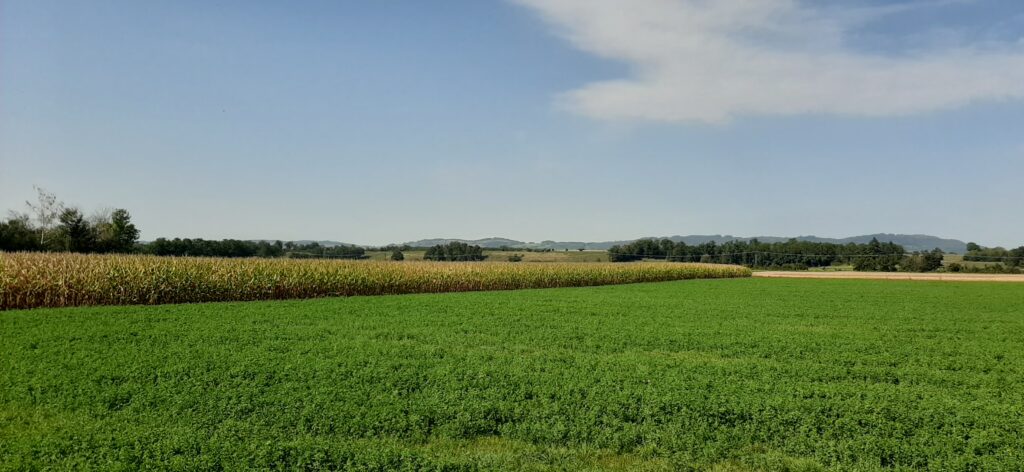[January 2022] If you happen to be walking among the fields of a flat rural area in France in spring and to notice the swaying flight of a charming bird of prey with long grey and black wings, or the acrobatic aerial courtship it displays with its brown female counterpart, pay closer attention… because you might be looking at an increasingly rare sight. The Montagu’s Harrier (Circus pygargus, see photo by Maurizio Biancarelli above, or Busard cendré in French) is a trans-Saharan migratory raptor that comes from as far as South Africa to breed in the plains of Europe, crossing over the Med via Tunisia, sometimes via the Gibraltar strait or the Middle East; it arrives in April, only to find that the stretches of indigenous wild vegetation, reed beds and meadows of tall grass where it ideally nests (on the ground, as opposed to all other birds of prey), are reducing in size every year. It therefore proceeds to establish its nest in the apparently safe vast fields of cereals nearby (such as wheat, rapeseed and barley) or lucerne, destined for mowing. The harrier adapts and it cannot imagine that combine harvester machines will suddenly come to raze the fields.
The nearly 4000 pairs found in France constitute one of the biggest remaining populations in Europe with Spain; in Asia, Montagu’s harriers are found between the Caspian See and western Siberia and central Asia, and they winter in India. The species is protected by law: globally, under CITES (the Convention for International Trade of Endangered Species) and under the 1982 Bonn convention, and in France under the 1972 law forbidding the hunting of any diurnal bird of prey.
With the other two harriers (the Hen Harrier and Western Marsh Harrier), the species is amongst the rarest in France, and is included in Annexe II of the Bern convention and Annexe I of the 1979 European Birds Directive, protecting it across the EU under designated protection zones as part of the Habitat Directive and within the Natura 2000 network.
French NGOs (non gov. organizations) have been fighting to protect these harriers since the 1980s, by involving the landowners and farmers: the species risks disappearing within the next twenty years, according to the LPO (Ligue Protection des Oiseaux), which conducts the most intense campaign each spring and summer, with hundreds of volunteers deployed in the fields. Thanks to them, over 2000 rescued young harriers depart in September for Africa yearly.
The regions of Poitou-Charentes, Champagne-Ardenne, Lorraine and Auvergne Rhone-Alpes are the main areas of distribution in France. In this latter region, where between 200 and 450 birds are saved each season, a Regional Action Plan includes: preserving the remaining wetlands and grass meadows, considered islands of biodiversity where the species can nest; finding the nests and protecting them from the harvest, which unfortunately happens in mid may, well before the chicks learn to fly (a real race against time considering the nests are very hard to find); when necessary raising the rescued chicks in rehabilitation centres like the ‘Tichodrome’, from where they can be freed in the fields where they learn to hunt small birds, lizards, country mice and large insects from an artificial nest; and all the while engaging in discussions with the farmers’ federation, which is in part familiar with these actions by now.

Despite all this, in Isere alone (Rhone-Alpes), where I live, the harriers’ numbers have halved in 20 years. In the plains of Bièvre (see photo above and ‘Special Places’) and of Liers, where 25 pairs are found on average, the regional LPO section deploys a dozen of volunteers who spend on average 200 hours each monitoring nests, building cages, adding electric wires against predators, establishing a dialogue with local farmers to obtain that specific square areas of grass around each nest be left untouched.
Since 2018 the search phase has been made easier and less invasive using a drone, but this is very expensive to rent or buy. When possible, nests are gradually moved to wild patches of land or adjacent fields of sunflowers or corn, which are harvested later in summer. On average 7 nesting birds out of ten survive till the following year. Longevity in the wild is around 16 years. A wing marking plan to monitor the harriers year to year is in the pipeline.
Funds collected by the LPO are used for materials, rent to put up the volunteers on site, food, transport, drone, vets… During the 2020 and 2021 pandemic, thanks to special permissions granted by the Ministry of Ecology, dedicated LPO volunteers and ornithologists have not given up on their mission to protect this and other rare species: vultures, bats, swallows, Bonelli’s eagles, loggerhead shrikes, little owls, ocellated lizards, red kites…
When the surviving harriers leave Europe for Africa via Gibraltar or Italy and Malta then cross the Sahara, they establish themselves near water sources or wetlands, like the rice fields of the Senegal river delta, or where the bush fires have transformed the tropical forests in wooded savanna. Here they face other challenges.
But next spring, their friends will still wait for them in the fields of France.
The Wild Charm Factory chooses to devolve 5% of all future sales to this project. Our Silver Hawk Wing cuff and ring (see ‘The Wild Charm’) have been designed to celebrate the Montagu’s Harrier.
![]()